The Manchester Murals

The Manchester Muralsare a series of twelve paintings byFord Madox Brownin the Great Hall ofManchester Town Halland are based on thehistory of Manchester.Following the success of Brown's paintingWorkhe was commissioned to paint six murals for its Great Hall. Another six murals were to be completed byFrederic Shieldswho later withdrew, leaving Brown to complete all twelve works. The murals were begun in 1879, towards the end of Brown's career, but were not completed until 1893, the year he died. During this period he moved from London to Manchester with his family, first living inCrumpsalland thenVictoria Park.
Location
[edit]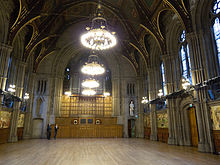
The murals form part of the decoration of the Great Hall, the central room designed byAlfred Waterhouse.[1]On entering the hall, six murals are on the left hand wall and six on the right, progressing chronologically from the left wall nearest the entrance to the right wall opposite, repeating the basic structure of the scheme ofWilliam Bell Scott's murals on the history ofNorthumbriainWallington Hall.
Subjects and meaning
[edit]The subjects chosen reflect the Victorian ideals through which the history of Manchester was seen, focusing on Christianity, commerce and the textile industry. The artist did a great deal of research to check the details for accuracy and he wrote their descriptions.
Recent commentators have identified satirical and critical features in the compositions which complicate any simple explanation of the paintings as expressions of "Victorian ideals" that the chosen subjects imply. The art historian Julie F. Codell refers to these as the "pratfalls and penultimates" of history, as opposed to its stately progress.[2]
Most of the paintings containHogarthian satire(in contrast to Bell Scott's works). In the first picture the wife of the Roman general wearing a blond wig distracts him from his work; their son – a Caligula in the making – kicks an African servant. The painting that seems to celebrate industrial technology,John Kay: Inventor of the Fly Shuttle,depicts the hysterical inventor fleeing from an unruly mob which is bent on destroying the machine. Instead of culminating in the achievement of modern Manchester, the sequence concludes with a rustic scene in a small village. According to Codell, history is portrayed as fragmented, contested, and as ending in a "penultimate" moment. This may be related to Brown's interest in anarchism andWilliam Morris'sutopian socialismat the time, but it also arises from disputes about the more modern subjects. Paintings depicting thePeterloo Massacrein 1819 and the end of theLancashire Cotton Faminein 1865 had been proposed, but were rejected by the council's committee as too controversial.
Technique
[edit]All but the last four murals were painted directly on to the wall. They were not created using the truefrescoprocess but taking advantage of a Victorian technique, theGambier Parry process,which was"spirit"based producing a more hard-wearing image. Brown completed the last four murals on canvas, after he had returned to live in London.
Murals
[edit]| Image | Description |
|---|---|
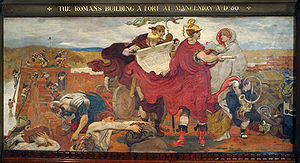
|
The Romans Building a Fort at Mancenion The mural depicts the building of a Roman fort by enslaved Britons while a Roman general gives the orders. The fort, now known asMamucium,was at what is now the area ofCastlefield,near the centre of Manchester. |
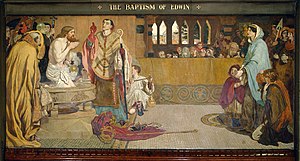
|
The Baptism of Edwin The mural depicts thebaptismofEdwin of Northumbria,who was also king ofDeirawhich included the Manchester area, atYork,watched by his Christian wifeEthelburgaand family. |

|
The Expulsion of the Danes from Manchester The mural depicts the retreat of theDanesfrom Manchester – showing soldiers carrying their general on a stretcher. |
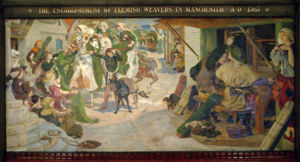
|
The Establishment of Flemish Weavers in Manchester A.D. 1363 QueenPhilippa of HainaultgreetsFlemishweavers who were invited to England underEdward III of England's act of 1337. |
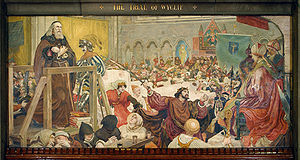
|
The Trial of Wycliffe A.D. 1377 John Wycliffeis depicted on trial, defended by his patron,John of Gaunt.Geoffrey Chaucer,another protégé of Gaunt's, acts as recorder. |

|
The Proclamation regarding Weights and Measures A.D. 1556 In 1556, Manchester's Court passed an edict directing that "The Burgess and others of the Town of Manchester shall send in all manner of Weights and Measures to be tried by their Majesties standard." |

|
Crabtree watching the Transit of Venus A.D. 1639 William Crabtree,a draper who lived inBroughton,was asked by a curate friend,Jeremiah Horrocks,to observe the Transit ofVenus,on 24 November 1639. Crabtree's diligence and rigour enabled him to correct Horrocks' faulty calculations and to observe the transit on 4 December. |

|
Chetham's Life's Dream A.D. 1640 The mural depicts merchant philanthropistHumphrey Chetham's dream of thecharity schoolfor poor boys founded in his will of 1653, which becameChetham's School of Musicin 1969. Chetham is portrayed studying his will to the right of the painting. |
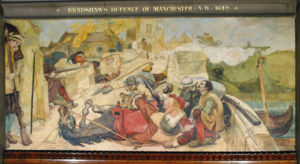
|
Bradshaw's Defence of Manchester A.D. 1642 During theEnglish Civil War,Manchester was besieged by Royalist troops under the command ofLord Strange.It was, however,John Rosworm,notJohn Bradshawas depicted, who defended the town. This was the last of the paintings to be completed. It is not strictly a mural, since Brown was by this time too frail to work in the hall. It was painted on canvas and adhered to the wall. |
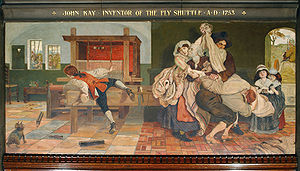
|
John Kay, Inventor of the Fly Shuttle A.D. 1753 The invention, byJohn Kay,of the flying shuttle revolutionised weaving. The mural depicts rioters, who feared their jobs were in danger, breaking in to destroy theloom,while Kay is being smuggled to safety. |

|
The Opening of the Bridgewater Canal A.D. 1761 The3rd Duke of Bridgewaterowned coal mines in Worsley, and collaborated with engineerJames Brindleyto build theBridgewater Canalto carry coal into Manchester. The Duke is shown standing on a barge decorated with flags of his coat of arms, observing the launch of the first coal barges on his new canal. He is accompanied by Brindley and theEarl and Countess of Stamford.[3] |

|
Dalton collecting Marsh-Fire Gas The mural depicts the scientistJohn Daltoncollecting gases. His studies led to the development ofatomic theory. |
See also
[edit]References
[edit]- ^Art and Architecture in Victorian Manchester,John G. Archer (ed.) xxi + 290 pp., Manchester University Press;Manchester Town Hall
- ^Codell, Julie F., "Ford Madox Brown, Carlyle, Macaulay and Bakhtin: The Pratfalls and Penultimates of History",Art History,Volume 21, Number 3, September 1998, pp. 324–366(43).See also, Ellen Harding, ed.,Reframing the Pre-Raphaelites: Historical and Theoretical Essays.Scolar Press, 1998.
- ^Treuherz, Julian (2011).Ford Madox Brown: Pre-Raphaelite Pioneer.Manchester City Art Gallery/Philip Wilson Publishers. pp. 304–305.ISBN9780856677007.Retrieved26 June2019.
External links
[edit] Media related toThe Manchester Muralsat Wikimedia Commons
Media related toThe Manchester Muralsat Wikimedia Commons- Ford Madox Brown Murals on the Manchester City Council website
- The Manchester Murals PaintingsbyHall Caine,The Magazine of Art,February 1882
